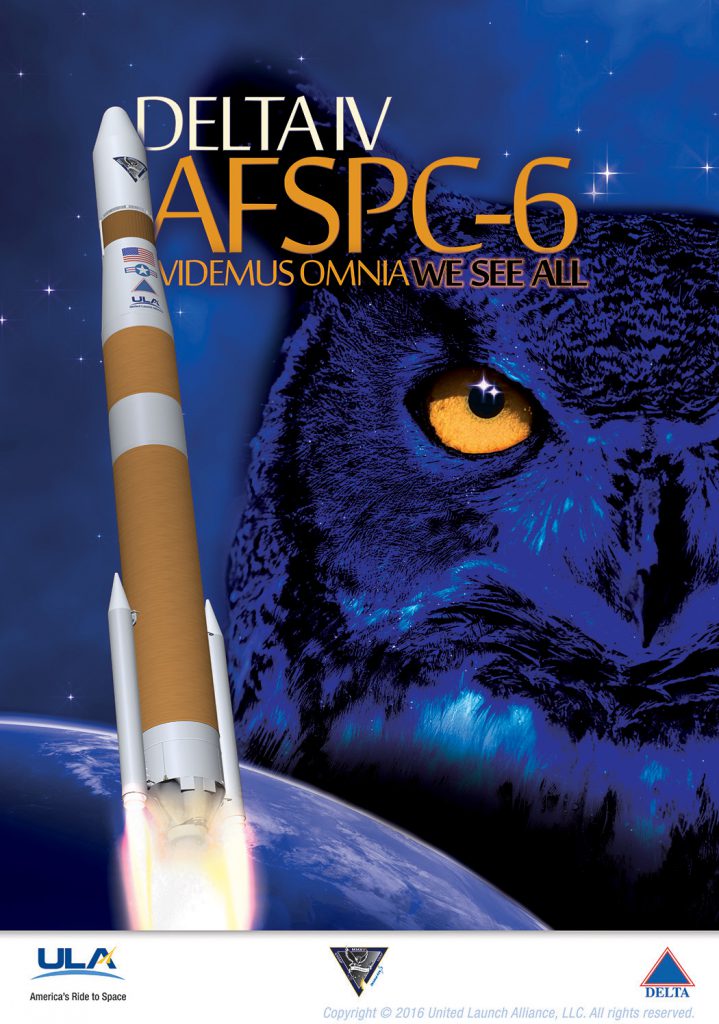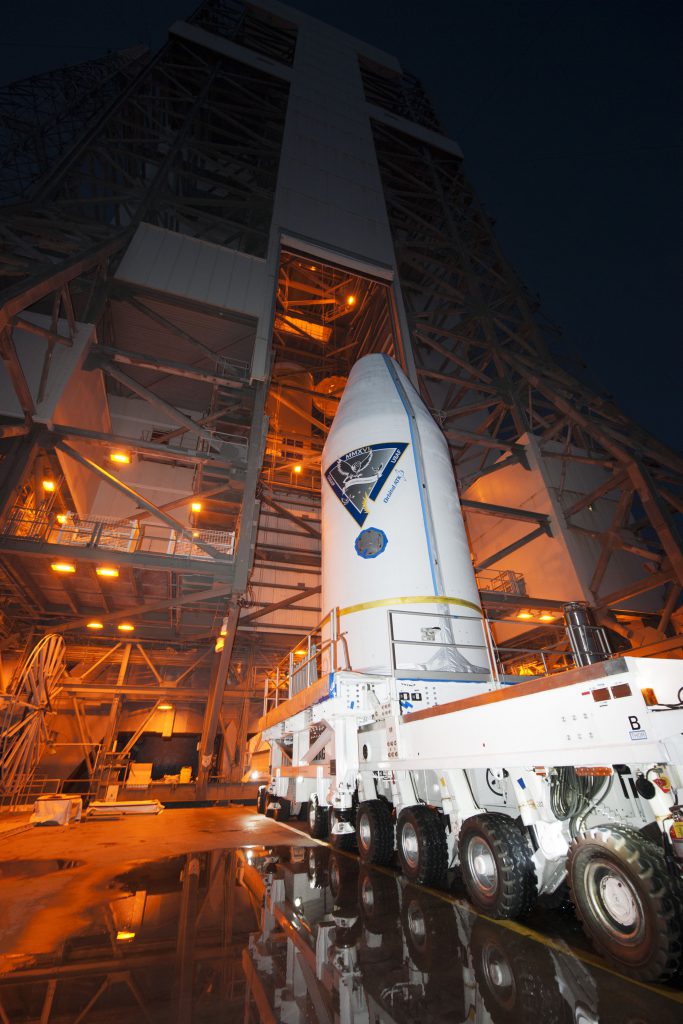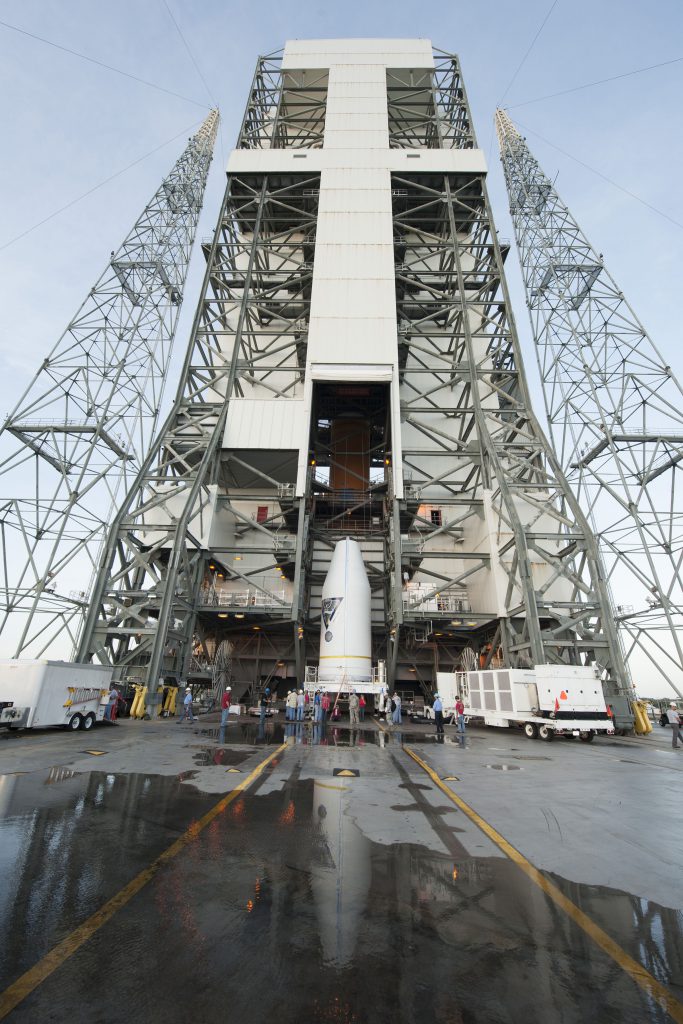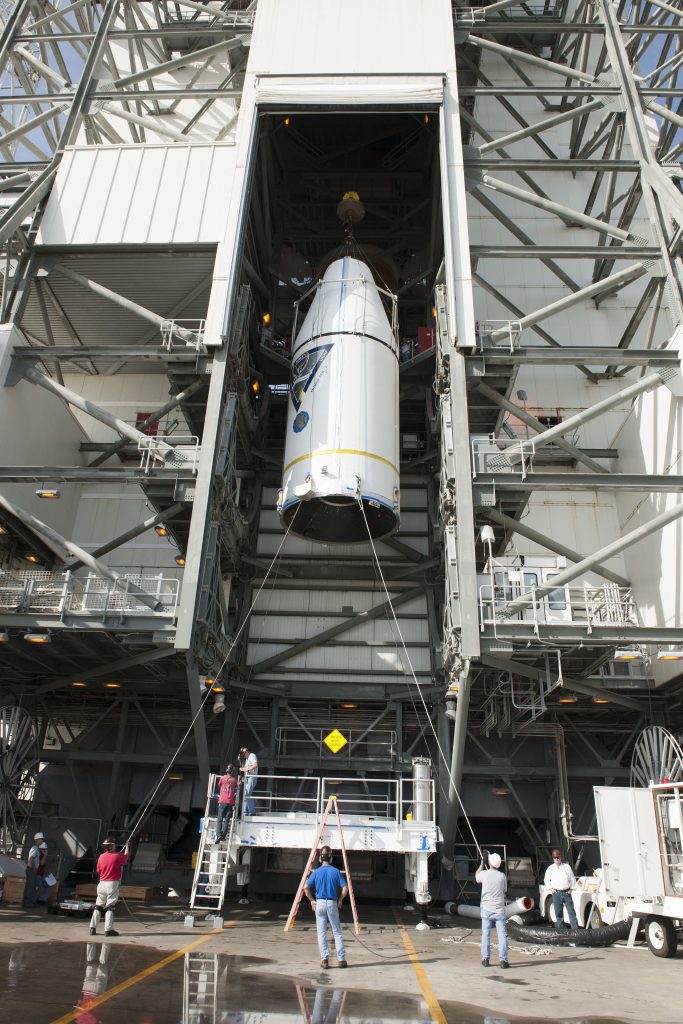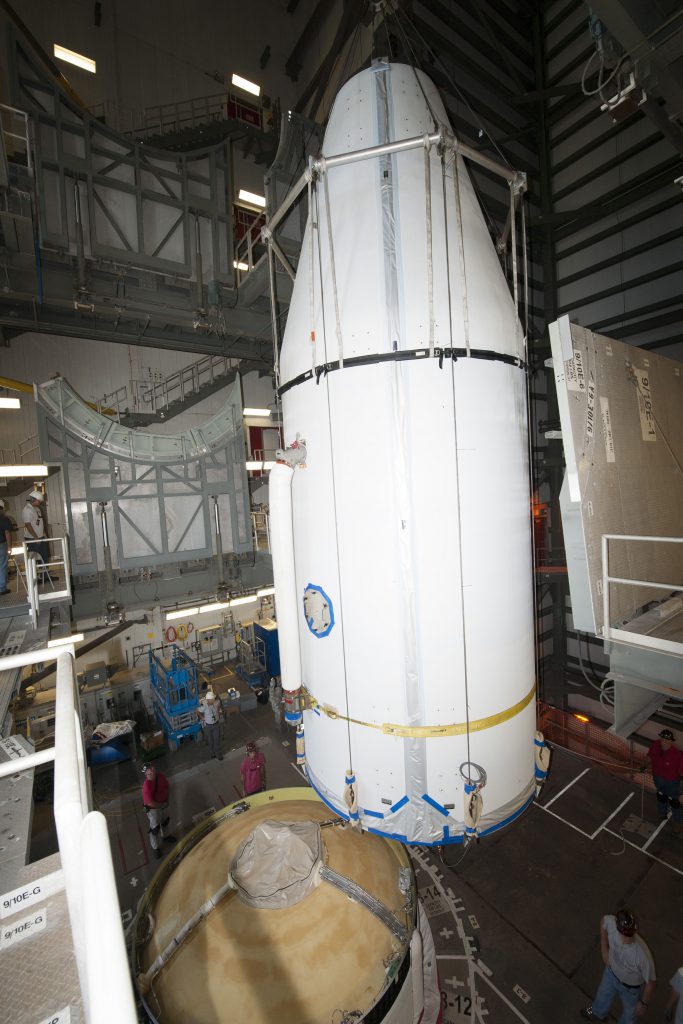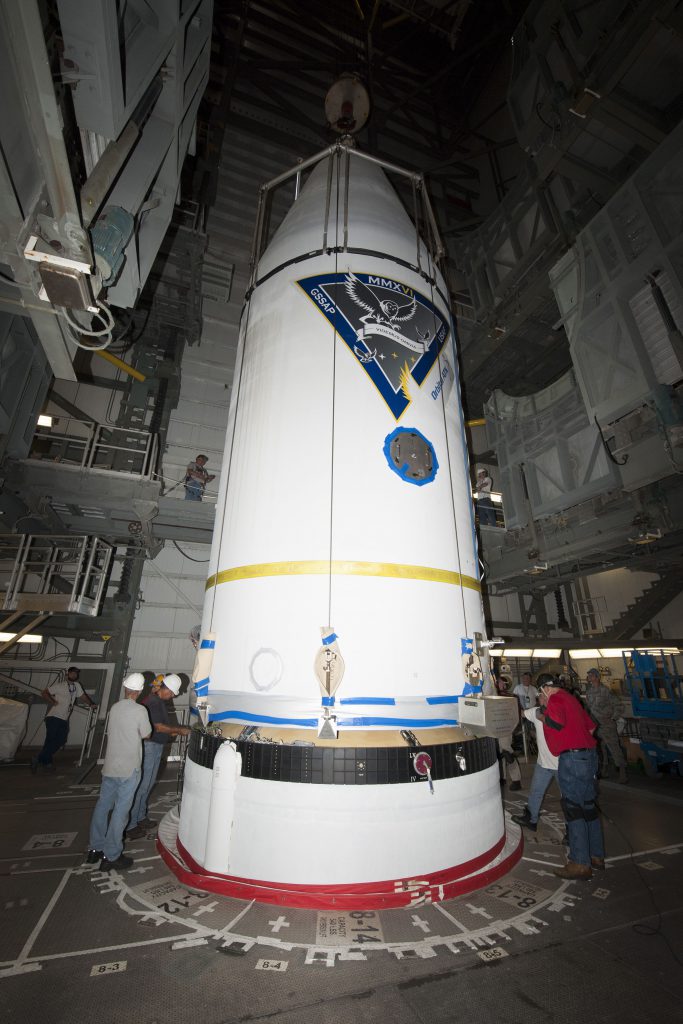The two Geosynchronous Space Situational Awareness Program, or GSSAP, satellites for the U.S. military were mounted aboard the United Launch Alliance Delta 4 rocket on Aug. 5. Photos and video of the operation were released today. Liftoff is planned for Aug. 19 from Cape Canaveral.
Photos and by United Launch Alliance
See earlier Delta 375 coverage.
Quelle: SN
-
Update: 17.08.2016
.
Nice forecast for Delta IV launch early Friday

Air Force Space Command disclosed the existence of the Geosynchronous Space Situational Awareness Program, or GSSAP, months before the first pair launched in 2014, also on a Delta IV rocket.
The rocket is flying in its "Medium+" configuration with two solid rocket boosters strapped to the first-stage booster.
If Wednesday's meetings conclude with a "go" to proceed toward the countdown, the mobile tower at Launch Complex 37 will roll back to reveal the 206-foot rocket later that evening.
The mission will be ULA's seventh this year, including four by Atlas V rockets and three by the Delta IV.
An Atlas V is being prepared for a Sept. 8 launch from Cape Canaveral of a NASA robotic science mission called OSIRIS-REx, which will attempt to visit an asteroid and return a sample to Earth.
-
The Air Force and United Launch Alliance will meet Wednesday to confirm their readiness to launch a Delta IV rocket and a pair of military satellites early Friday from Cape Canaveral.
The launch is targeted for 12:37 a.m. Friday, Aug. 19, at the opening of a 75-minute window extending to 1:52 a.m.
Weather doesn't look like it will be an issue: The Air Force's 45th Space Weather Squadron predicts an 80 percent chance of acceptable conditions during the window, and the same odds Saturday, should the launch slip a day.
On top of the rocket is the second of two pairs of satellites designed to patrol an orbit roughly 22,000 miles above the equator, on the lookout for potential threats to U.S. spacecraft flying in that region.
Air Force Space Command disclosed the existence of the Geosynchronous Space Situational Awareness Program, or GSSAP, months before the first pair launched in 2014, also on a Delta IV rocket.
The rocket is flying in its "Medium+" configuration with two solid rocket boosters strapped to the first-stage booster.
If Wednesday's meetings conclude with a "go" to proceed toward the countdown, the mobile tower at Launch Complex 37 will roll back to reveal the 206-foot rocket later that evening.
The mission will be ULA's seventh this year, including four by Atlas V rockets and three by the Delta IV.
An Atlas V is being prepared for a Sept. 8 launch from Cape Canaveral of a NASA robotic science mission called OSIRIS-REx, which will attempt to visit an asteroid and return a sample to Earth.
Quelle: Florida Today
-
Update: 19.08.2016
.
U.S. Air Force set to launch next GSSAP spacecrafts
LOS ANGELES AIR FORCE BASE, El Segundo, Calif. – The U.S. Air Force is scheduled to launch the third and fourth Orbital/ATK built Geosynchronous Space Situational Awareness Program (GSSAP) satellites aboard a United Launch Alliance Delta IV launch vehicle Aug. 19.
The mission, called AFSPC-6, will deliver two Geosynchronous Space Situational Awareness Program satellites into orbit to further the space situational awareness mission.
Two GSSAP satellites are currently on-orbit and meeting all mission requirements. The GSSAP satellites provide improved GEO based Space Situational Awareness (SSA) that will enhance the ability of the Joint Functional Component Commander for Space (JFCC-SPACE) to provide enhanced space safety of flight and better understand the ever evolving state of affairs in the GEO belt.
“The first two GSSAP satellites have performed remarkably well,” said Lt. Gen. Samuel Greaves, SMC commander and Air Force program executive officer for space. “These next two satellites will add to that capability and enable us to understand more completely things what occurs in the geosynchronous orbit to a very high quality. It’s a key piece in the puzzle for space situational awareness.”
Operated by Air Force Space Command, the GSSAP System provides precise data seven days a week, 24-hours a day.
The satellites will join a GSSAP constellation that is supporting U.S. Strategic Command space surveillance operations as a dedicated Space Surveillance Network sensor. The GSSAP also supports the JFCC-SPACE by collecting SSA data, allowing for more accurate tracking and characterization of man-made orbiting objects.
SMC and its mission partners will conduct the mission launch aboard a Delta IV Medium-plus configuration Evolved Expendable Launch Vehicle. The EELV program was established by the United States Air Force to provide assured access to space for Department of Defense and other government payloads. The commercially developed EELV program supports the full range of government mission requirements, while delivering on schedule and providing significant cost savings over the heritage launch systems.
Air Force Space Command's Space and Missile Systems Center, located at Los Angeles Air Force Base, California, is the U.S. Air Force's center of acquisition excellence for acquiring and developing military space systems. Its portfolio includes the Global Positioning System, military satellite communications, defense meteorological satellites, space launch and range systems, satellite control networks, space based infrared systems and space situational awareness capabilities.
Quelle: USAF
---
Delta IV Set for GEO 'We See All' Mission
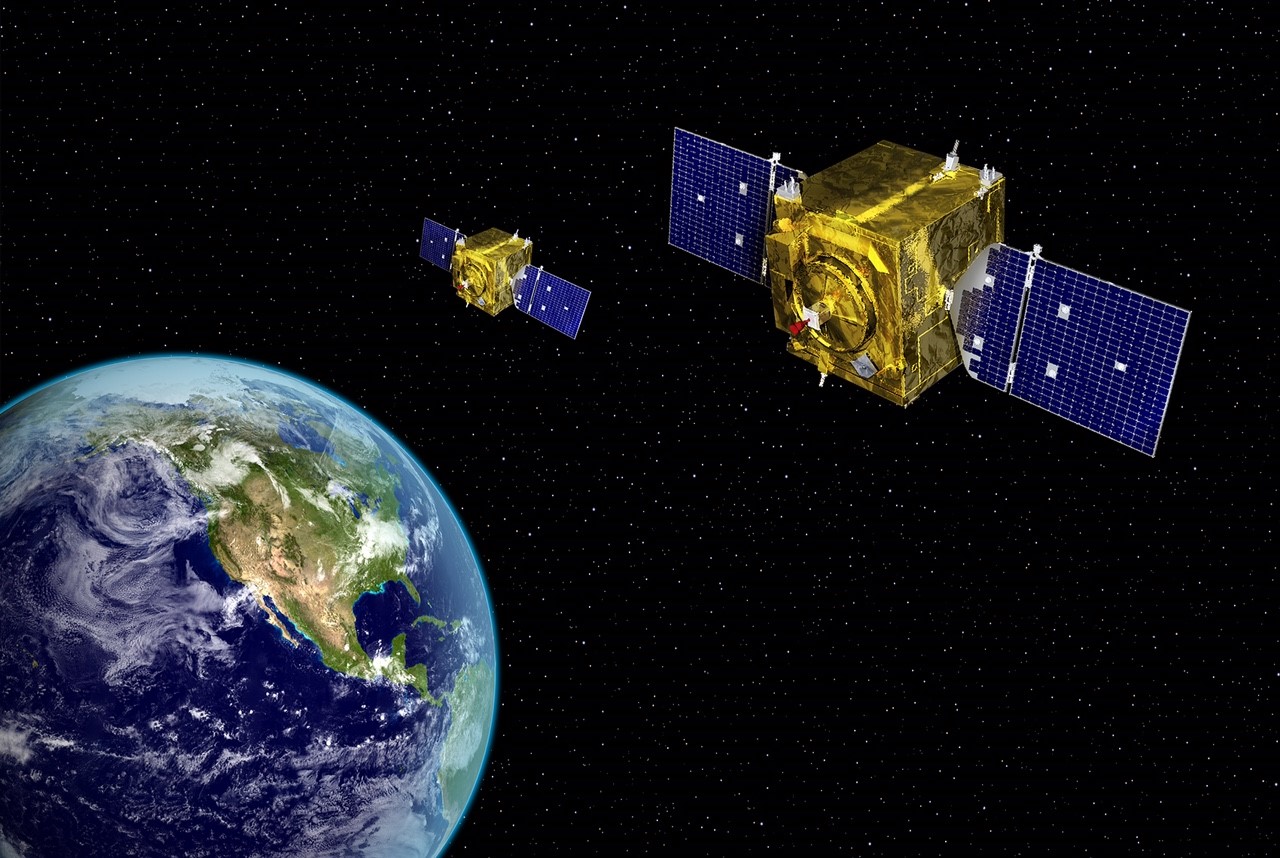
Air Force graphic depicts two GSSAP spacecraft operating in geosynchronous orbit at 22,300-mile altitude. Image Credit Air Force Space Command.
The U.S. Air Force is poised to double its geosynchronous orbit space situational awareness and satellite-to-satellite imaging with the planned Aug. 19 predawn launch of two Geosynchronous Space Situational Awareness Program (GSSAP) satellites on board a United Launch Alliance (ULA) Delta IV Medium 4,2 vehicle with two solid rocket boosters.
The mission seal on the Delta IV fairing includes three owls, two of them holding a streamer in Latin that reads “Videmus Omnia,” which translates to “We See All”—a warning to Russians and Chinese that any attempt to physically attack U.S. satellites will be detected by the U.S. GSSAP (pronounced “GeeSap”) spacecraft.
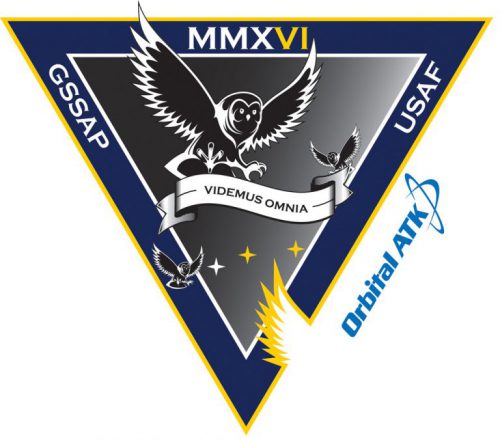
Mission insignia depicts owls carrying a banner that reads VIDEMUS OMNIA, Latin for “We See All.” Image Credit: U.S. Air Force
Liftoff of the 206-foot-tall, 1.1 million lb-thrust Delta IV is set for 12:47 a.m. EDT at the opening of a 65-minute launch window that closes at 1:52 a.m. EDT. The mission will fly from Space Launch Complex (SLC)-37B at Cape Canaveral Air Force Station, Fla.
The satellites will not be released from the Delta’s second stage until about six hours after launch. The mission is designated Air Force Space Command (AFSPC-6).
The oxygen/hydrogen Rocketdyne Aerojet RS-68A engine for the first stage will generate 702,000 lbs of liftoff thrust, while each Orbital ATK GEM 60 solid rocket booster will add another 197,500 lbs thrust for the first 93 seconds of flight.
The first stage will continue to fire until its cutoff at 3 minutes, 58 seconds into the flight, followed by first stage separation 8 seconds later.
Ignition of the second stage at 4 minutes, 20 seconds will be followed by payload fairing separation at 4 minutes, 30 seconds.
Launch commentary will then cease to avoid providing clues on the trajectory to Russian and Chinese intelligence services.
The twin Orbital ATK-built Air Force Space Command satellites will join two others launched on July 28, 2014.
Mounted side by side under the two halves of the 13-foot-wide, nearly 40-foot-long launch shroud, the AFSPC-6 satellites will be boosted directly into geosynchronous orbit. They will remain attached to the Delta IV’s 25,000 lb-thrust Aerojet Rocketdyne RL10B-2 cryogenic upper stage until they reach about 22,300 miles altitude.
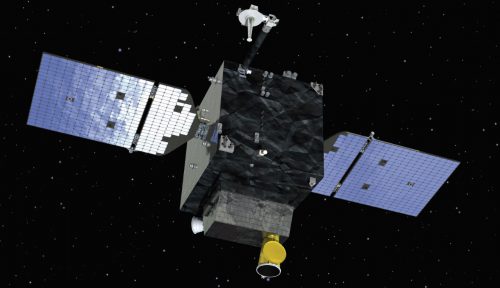
Each GSSAP satellite uses the Orbital ATK GEOStar-1 design weighing nearly nearly 1,500 lb. Image Credit: Orbital ATK
The two Orbital ATK GSSAP-3 and 4 spacecraft will join GSSAP-1 and GSSAP-2 to drift above and below the geosynchronous arc at about 22,300 miles altitude, where they can image and eavesdrop on primarily Chinese and Russian spacecraft. The new USAF satellites are capable of proximity operations where, with great care, they will be maneuvered around individual Russian and Chinese satellites.
There are currently about 600 satellites in geosynchronous orbit, including operational and backup as well as expired spacecraft. GSSAP controllers at the 50th Space Wing, Schriever AFB, Colo., and the Intelligence Community as a whole, want to look at them all to understand if there are any collision threats posed by these spacecraft as they move about in an internationally assigned box about 50 miles on a side.
The most key GSSAP mission, however, is to make sure no Russian and Chinese spacecraft —or their orbiting ASAT systems—pose threats to U.S. and allied satellites in geosynchronous orbit. They include:
—American and allied military communications satellites
—National Reconnaissance Office (NRO) Elint/Sigint eavesdropping satellites
— Air Force missile warning spacecraft
—NASA and NRO relay satellites
—NASA and NOAA scientific satellites
— U. S. and allied civilian communications spacecraft
According to the Air Force the GSSAP project was developed “to achieve an operational space-based situational awareness capability operating in the near-geosynchronous orbit regime to deliver data to the U.S. Strategic Command.”
GASSP operates in a team effort “with ground-based telescopes and radars to keep track of space objects and identify potential threats to U.S. satellites,” the Air Force said.
According to Spaceflight 101.com, “The project was developed covertly and the identity of the satellites was a secret until the program was declassified in early 2015.”
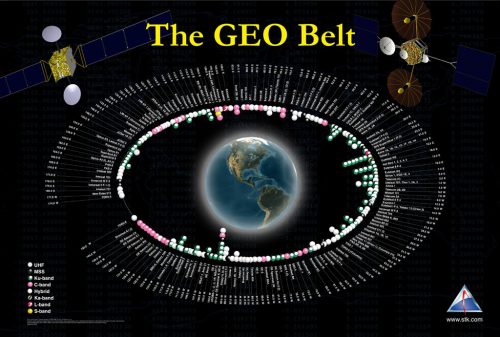
Depiction of about 600 satellites in geosynchronous orbit illustrates the challenge facing GSSAP operations. Image Credit: Analytical Graphics.
The first two satellites launched were to undergo a year of testing, but were pressed into service early on a secret mission to image a specific spacecraft, either foreign or U.S.
Air Force General John Hyten, commander of Space Command, told an Air Force Assn. meeting that when pressed into service early, the satellites “performed remarkably.”
“The users that requested the information are extremely pleased with the pictures we gave them,” Hyten said. “The pictures are truly eye-watering,” he told an Air Force Association press conference. “It’s amazing, you don’t often get to see satellites flying in space.” Other Air Force sources said centimeter scale resolution is necessary for examination of satellite antennas and sensors.
As initially conceived the Air Force believed the first pair would fly with one satellite above and the other below the geosynchronous plane. But the SeeSat-L satellite tracking group, headed by Canadian Ted Molczan, has found sometimes both operational satellites have also operated below the geosynchronous belt. Molczan also said sometimes the spacecraft have operated in tandem and other times while widely separated.
He said the GSSAP-1 satellite has been drifting at a velocity of one-half to a full degree per day, while GSSAP-2 has flown more slowly at one-fourth to one-third of a degree per day, occasionally pausing for observations at a single location.
Each GSSAP was developed from the Orbital ATK GEOStar-1 bus that weighs 1,102 lbs, with the capability to carry an additional 330 lb-sensor payload, including high resolution imaging sensors and possibly top secret eavesdropping electronics. This means that each spacecraft with the bus and payload combined weighs about 1,430 lbs.
These are extremely high performance satellites with large propellant tanks, giving each satellite 3,281 fps of maneuvering capability. The GEOStar bus with “precision pointing, knowledge, and agility combined with a large delta-v capacity make it a premier spacecraft for small GEO missions,” says an Orbital ATK marketing document.
Quelle: AS
-
Update: LIVE-Frams von Delta-4 Start
.




---




Quelle: ULA
-
Update:
Delta 4 rocket launches space surveillance satellites

A United Launch Alliance Delta 4 rocket blasted off from Cape Canaveral early Friday carrying a pair of military space surveillance satellites toward orbit.
By the light of a nearly full moon, a United Launch Alliance Delta 4 rocket thundered to life and climbed away from Cape Canaveral early Friday, putting on a spectacular overnight show as it boosted a pair of military space surveillance satellites toward orbit.
While the identity of the satellites and their general nature were not classified, ULA ended its launch video and commentary less than five minutes after liftoff, “at our customer’s request,” and the rest of the climb to orbit was carried out in secrecy.
This was the second launch of two Geosynchronous Space Situational Awareness Program, or GSSAP, satellites following an initial launching of two such spacecraft in 2014.
The satellites, built by Orbital ATK, are designed to operate just above and below the 22,300-mile-high geosynchronous altitude favored by communications stations, electronic eavesdropping spysats, weather satellites and other high-value spacecraft. At that altitude, it takes satellites 24 hours to complete one orbit and they appear to hang stationary in the sky.
The first two satellites “have performed remarkably well,” Lt. Gen. Samuel Greaves, commander of the Air Force Space and Missile Systems Center at Los Angeles Air Force Base in El Segundo, Calif., said in a statement Thursday.
“These next two satellites will add to that capability and enable us to understand more completely what occurs in the geosynchronous orbit to a very high quality. It’s a key piece in the puzzle for space situational awareness.”
Congressional testimony by Douglas Loverro, deputy assistant secretary of defense for space policy, said in 2014 that the GSSAP satellites are able to “survey objects in the GEO belt and allow us both to track known objects and debris and to monitor potential threats that may be aimed at this critically important region. In short, threats can no longer hide in deep space.”

A time exposure captures the Delta 4 launch from nearby Merritt Island, FL.
Loverro said the decision to declassify and openly talk about the GSSAP system was straight forward.
“We need to monitor what happens 22,000 miles above the Earth, and we want to make sure that everyone knows we can do so,” he told a subcommittee of the Senate Committee on Armed Services.
“We believe that such efforts add immeasurably to both the safety of space flight and the stability that derives from the ability to attribute actions -- to the benefit of all space-faring nations and all who rely on space-based services.”
Earlier this summer, one of the first two GSSAPs apparently was used to inspect a military communications satellite launched in June that is now stranded in a useless orbit. A malfunction of some sort has prevented on-board thrusters from circularizing the satellite’s initially elliptical orbit at geosynchronous altitude.
The GSSAP apparently was commanded to inspect and presumably photograph the MUOS 5 communications satellite near the high point of its orbit, but the results have not been discussed and it’s not known what, if anything, might be done to help the stranded satellite.
But according to Space News, Gen. John Hyten, director of Air Force Space Command, said last year that the GSSAP satellites had captured “truly eye watering” images of other spacecraft and similar imagery of MUOS 5 may have been sent down to troubleshooters.
While the general thrust of the GSSAP program is unclassified, operational details are, and Friday’s launching provided no additional details.
The mission began at 12:52 a.m. EDT (GMT-4) when the 206-foot-tall Delta 4’s hydrogen-fueled Aerojet-Rocketdyne RS-68A main engine roared to life with a burst of fiery exhaust, followed an instant later by ignition of two strap-on solid-fuel boosters.
Trailing a brilliant plume of fiery exhaust visible for miles around, the Delta 4 quickly climbed away from launch complex 37 at the Cape Canaveral Air Force Station atop 1.2 million pounds of thrust, arcing away on an easterly trajectory over the Atlantic Ocean.
The early moments of the flight appeared normal and the solid fuel boosters burned out and fell away about a minute and 33 seconds after liftoff. The first stage followed suit two-and-a-half-minutes later and the rocket continued toward space under the power of a single hydrogen-fueled Pratt & Whitney Rocketdyne RL10B-2 engine.
United Launch Alliance ended video coverage and commentary four-and-a-half minutes into flight, well before the satellite payload reached orbit. But up to that point, there were no apparent problems.
Quelle: CBS

